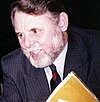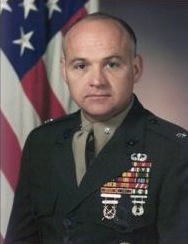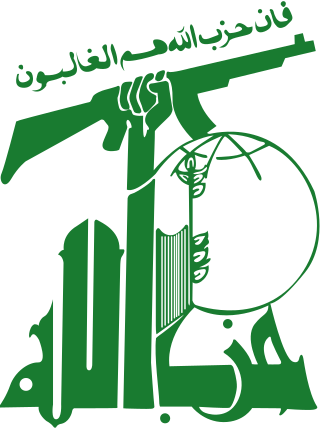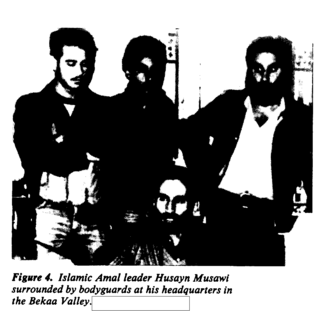Hostages
With the exception of a few hostages such as CIA Bureau Chief William Francis Buckley and Marine Colonel William Higgins (who were both killed), most of the hostages were chosen not for any political activity or alleged wrongdoing, but because of the country they came from and the ease of kidnapping them. Despite this, the hostages complained of and had physical signs of mistreatment, such as repeated beatings and mock executions. [16]
Some of the hostages were:
- David S. Dodge. Among the first victims whose case was widely publicized was American University of Beirut president David Dodge, abducted 19 July 1982 and freed on July 21, 1983. According to Lebanese journalist Hala Jaber, "Dodge was abducted initially by pro-Palestinian Lebanese" in hopes of pressuring the Americans to pressure Israel which had invaded Lebanon to stop Lebanon-based PLO attacks. After the PLO evacuated Lebanon, Dodge was taken into Iranian custody, and moved him from Beqaa Valley to Tehran. The Iranians hoped to use Dodge to gain the release of four Iranian officials who had been kidnapped by Lebanese Christians in July 1982. The four Iranians were never found. [17] Dodge spent the next three months in Evin Prison, and was asked for information about the kidnapped Iranians whenever he was interrogated. [17] He was released, reportedly, because Syrian President Assad was angered by Iran's involvement in the kidnapping. Dodge was released from captivity and driven back to the airport by an official of the Iranian Revolutionary Guards. He flew to Damascus, and was handed over to the American embassy on arrival there. [18]
- Benjamin Weir. The Presbyterian minister was kidnapped in May 1984 by three armed men while strolling with his wife. Weir may have thought he was safe from harm from Muslims because he lived in Shiite West Beirut working with Muslim charities, and had lived in Lebanon since 1958. Two days after his abduction, a telephone message claimed: "Islamic Jihad organization claims it is responsible for the abduction ... in order to renew our acceptance of Reagan's challenge [to fight "state terrorism"] and to confirm our commitment of the statement ... that we will not leave any American on Lebanese soil". [19] He was released mid-September 1985.
- Terry A. Anderson, chief Middle East correspondent for the Associated Press, was the longest held hostage believed to be captured by Shiite Hezbollah or Islamic Jihad Organization. Anderson was seized on March 16, 1985, finally being released December 4, 1991. [20]
- Charles Glass, an American television correspondent, was seized on June 17, 1987, by a previously unknown group, the "Organization for the Defense of Free People", believed to be one of Hezbollah's aliases. He escaped 62 days later. [20]
- Rudolf Cordes and Alfred Schmidt, two citizens of West Germany, were abducted in January 1987 by an organization calling itself "Strugglers for Freedom". The West Germans were seized shortly after the West German government arrested Mohammed Ali Hamadi, a Shia terrorist leader who allegedly masterminded the 1985 TWA Flight 847 hijacking and killed diver Robert Dean Stethem. Mohammed Ali Hammadi was not released at that time, but was apparently exchanged in 2006 for a German hostage then held in Iraq. [21] Schmidt was released in September 1987. Cordes was released in September 1988. [22] [23]
- Thomas Sutherland, former Dean of Agriculture at the American University of Beirut in Lebanon, was kidnapped by Islamic Jihad members near his Beirut home on June 9, 1985. [24] He was released on November 18, 1991, at the same time as Terry Waite, [25] having been held hostage for 2,353 days. [25]

- Terry Waite, an Anglican church envoy, disappeared on January 20, 1987, while on a negotiating mission to free the other kidnap victims. He spent almost five years in captivity, nearly four years of it in solitary confinement, after he was seized by Islamic Jihad from a go-between's house in Lebanon. Before his release in November 1991 he was frequently blindfolded, as well as having been beaten early in his period of imprisonment and subjected to a mock execution. He was chained, suffered desperately from asthma, and was once transported in a refrigerator as his captors moved him about. [26]

- Joseph J. Cicippio, who was working as the acting comptroller at the American University in Beirut when he was taken hostage on September 12, 1986. He spent 1,908 days in captivity, and released on December 2, 1991. He spent most of his time chained in a small room with one other hostage. [27] Following his release, Cicippio was one of several that successfully sued Iran for damages as sponsoring Hezbollah under the Foreign Sovereign Immunities Act, being awarded US$30 million. His children subsequently attempted to sue Iran for emotional damages Cicippio-Puleo v. Islamic Republic of Iran (2004) but which was dismissed by the courts as the Foreign Sovereign Immunities Act did not allow for foreign nations to be subject to private cause of action lawsuits, which led to Congress making a significant changes to FSIA in 2008 to enhance terrorist exceptions in sovereign immunity and assure foreign nations were responsible for actions of their officials tied to state-sponsored terrorism. [28]
Killed
- William Francis Buckley. Former CIA Bureau Chief, Beirut, taken hostage by Islamic Jihad, Mar 16, 1984. [26] and held at the village of Ras al-Ain. [29] On October 3, 1985, the Islamic Jihad Organization claimed to have killed him. The Islamic Jihad Organization later released to a Beirut newspaper a photograph purporting to depict his corpse. Press reports stated that Buckley had been transferred to Iran, where he was tortured and killed. Former American hostage David Jacobsen revealed that Buckley actually died of a heart attack brought on by torture, probably on June 3, 1985. [30] [31] His remains were found in a plastic sack on the side of the road to the Beirut airport in 1991. [32]
- Alec Collett, a British employee for UNRWA, was kidnapped along with his Austrian driver on March 25, 1985. The Austrian was only briefly held then released. In a videotape released in April 1986, Collett was shown being hanged by his kidnappers. Collett's body was not found until November 2009. [33]
- Four Soviet diplomats were kidnapped on September 30, 1985. Arkady Katkov, a consular attaché, was killed by his captors; the other three (Oleg Spirin, Valery Mirikov, and Nikolai Svirsky) were released a month later. [20] According to a 1986 report by the Jerusalem Post , the release of the hostages occurred following the kidnapping and murder of a key Hezbollah leader by the KGB. [34]
- Michel Seurat. On February 10, 1986, the Islamic Jihad Organization released a photograph that claimed to show the body of French sociologist Michel Seurat, who had been kidnapped earlier. On 5 March 1986 Islamic Jihad claimed it had executed Seurat. His fellow hostages revealed on their release that Seurat had died of hepatitis. His body was found in October 2005. [35] [36]
- Peter Kilburn, Leigh Douglas, and Philip Padfield. On April 17, 1986, the bodies of these three American University of Beirut employees, American citizen Peter Kilburn and Britons Leigh Douglas and Philip Padfield, were discovered near Beirut. The Revolutionary Organization of Socialist Muslims claimed to have executed the three men in retaliation for the United States air raid on Libya on April 15, 1986. [20]

- Another American military man killed by Hezbollah abductors was Colonel William R. Higgins. He was captured February 17, 1988, and taken hostage while serving on a United Nations (UN) peacekeeping mission in southern Lebanon. A year and a half after his capture, a videotape was released by his captors showing his body hanging by the neck. On December 23, 1991, his body was recovered from a Beirut street where it had been dumped.
- A further victim was Dennis Hill, an English lecturer at the American University of Beirut, originally from Middlesex, UK. Hill, aged 53, had worked for the American University of Beirut on the Intensive English Language Program since October 1984. He was shot several times in the head on May 30, 1985, while attempting to escape from his captors, according to the Associated Press. [37] [38] Islamic Jihad denied responsibility for the killing which it blamed on the CIA, (along with an attempted assassination of the Emir of Kuwait and bombing in Saudi Arabia). [39]
Escaped or rescued
- Frank Regier. An American engineering professor at the American University of Beirut. He was kidnapped on February 10, 1984 when he walked off the campus grounds. He was freed after several months in captivity by Amal militiamen, who raided the Beirut hideout of his extremist captors on April 15, 1984. Islamic Jihad responded by threatening Amal. [40]
- Christian Joubert. A French architect working with a Lebanese construction company. He was kidnapped on February 15, 1984 in West Beirut. He was rescued on April 15, 1984 along with Frank Regier. [41]
- Jonathan Wright. A British journalist who escaped from his captors in September 1984. [42]
- Jeremy Levin. An American journalist and bureau chief for CNN. He was kidnapped on March 7, 1984 while walking to his office in West Beirut. [41] On February 14, 1985, he escaped from his captors in the Beqaa Valley. Shia militants claimed they had allowed him to escape and the U.S. publicly thanked Syria for intervening on his behalf. [43]
- Michel Brillant. A French teacher working at the French Protestant College. [44] He was kidnapped on April 9, 1986 in Hamra and was released four days later on April 13, 1986 in the Beqaa Valley. [45]
- Husayn Farrash. A Saudi Arabian diplomat. He was kidnapped in West Beirut on January 17, 1984. [46] He was freed on July 16, 1986, when the Lebanese Army caught his captors. [20]
- David Hirst. On September 26, 1986, British journalist David Hirst escaped by bolting from his captors' automobile in a Shia neighborhood of Beirut. [20]
- Jean-Marc Sroussi several days later (from September 26, 1986) French television correspondent Jean-Marc Sroussi escaped from a locked shed days after his capture. [20]












